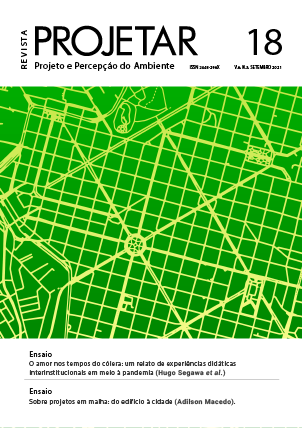ESPAÇOS ABERTOS DO HOSPITAL ESPÍRITA DE PORTO ALEGRE
USO EM REVISÃO POR UM AMBIENTE APOIADOR
DOI:
https://doi.org/10.21680/2448-296X.2021v6n3ID25171Palavras-chave:
jardim de cura; arquitetura da paisagem; espaços abertos; dependência química.Resumo
No artigo é examinada a temática do jardim de cura como um recurso na arquitetura da paisagem, para o suporte à terapêutica tradicionalmente aplicada à reabilitação de dependentes químicos, assunto ainda pouco disseminado no país, e na América Latina. Mas será que o potencial terapêutico da natureza é explorado de maneira adequada para atuar como parte ativa na reabilitação de indivíduos adictos? A partir do estudo de caso desenvolvido junto ao Hospital Espírita de Porto Alegre, nesta pesquisa procura-se evidenciar a matéria do jardim de cura, e divulgá-la como uma ferramenta no planejamento dos espaços abertos para o restabelecimento da saúde humana. O artigo é uma pesquisa qualitativa em que são empregadas as técnicas metodológicas survey e observação. Além disso, está assente em relevantes referências bibliográficas que permeiam o tema, no exame de normativas que regulamentam os espaços abertos de instituições desta especialidade, na apresentação de notáveis exemplares de jardins de cura, e na abordagem de teoria que apoia a relação entre natureza e bem-estar. Dentre os desfechos do estudo, é sublinhada a necessidade de reformulação dos regulamentos que normatizam os espaços abertos de entidades dedicadas à reabilitação de adictos.
Downloads
Referências
AGÊNCIA NACIONAL DE VIGILÂNCIA SANITÁRIA (ANVISA). Resolução RDC n. 29, de 30 de Junho de 2011. Dispõe sobre os requisitos de segurança sanitária para o funcionamento de instituições que prestem serviços de atenção a pessoas com transtornos decorrentes do uso, abuso ou dependência de substâncias psicoativas. Diário Oficial da União, Brasília, 1 jul. 2011.
ANTONOVSKY, Aaron. Health, stress and coping. San Francisco: Jossey-Bass, 1979.
BASTOS, Francisco Inácio Pinkusfeld Monteiro et al. (Org.). III Levantamento Nacional sobre o uso de drogas pela população brasileira. Rio de Janeiro: FIOCRUZ/ICICT, 2017. 528 p.
BENGTSSON, Anna; GRAHN, Patrik. Outdoor environments in healthcare settings: a quality evaluation tool for use in designing healthcare gardens. Urban Forestry & Urban Greening, [S.l.], v. 13, n, 4, p. 878-891, 2014. Disponível em: <http://dx.doi.org/10/1016/j.ufug.2014.09.007>. Acesso em: 25 out. 2018.
BERMAN, M.G. et al. Interacting with nature improves cognition and affect for individuals with depression. Journal of affective disorders, [S.l.], v. 140, n. 3, p. 300–305, nov. 2012.
BJÖRK, Jonas. et al. Recreational values of the natural environment in relation to neighbourhood satisfaction, physical activity, obesity and wellbeing. Journal of epidemiology and community health, London, v. 62, n. 4, apr. 2008.
BURNETT, J. Therapeutic effects of landscape architecture. In: MARBERRY, S. O. (ed.). Healthcare design. New York: John Wiley, 1997. p. 255-274.
FEBRACT. Disponível em: < https://febract.org.br/portal/>. Acesso em: 02 set. 2020.
FOWLER, Floyd J. Design and evaluation of survey questions. In: BICKMAN, Leonard; ROG, Debra J. (Org). Handbook of applied social research methods. California: Sage, 1998. p. 343-374.
FRANCIS, Mark; LINDSEY, Patricia; STONE, Jay. (Ed.). The healing dimensions of people-plant relations: proceedings of a research symposium. Davis: University of California, 1994. p. 5-12.
GIL, Antônio Carlos. Métodos e técnicas de pesquisa social. 5. ed. São Paulo: Atlas, 1999.
GRAHN, Patrik. Människans behov av parker, grönska och recreation. Sveriges Lantbruksuniversitet, Alnarp, v. 85, n. 7, 1985.
GRAHN, Patrik. Om parkers betydelse (On the meaning of parks). Stad & Land, Alnarp, n. 93, 1991.
GRAHN, Patrik. Green structures: the importance for health of nature areas and parks. The challenges facing European society with the approach of the year 2000, Council of Europe, [S.l.], n. 56, p. 89-112. 1994.
GRAHN, Patrik et al. Using affordances as a health-promoting tool in a therapeutic garden. In: INNOVATIVE approaches to researching landscape and health. London: Taylor & Francis, 2010. p. 116-154.
GRAHN, Patrik. Om stödjande miljöer och rofyllda (On supportive environments and restful sounds). In: MOSSBERG, F. (Ed.). Ljudmiljö, hälsa och stadsbyggnad. Lund: Ljudmiljöcentrum, Lunds universitet, 2011. p. 42-55.
GIFFORD. Robert; STEG, Linda; RESER, Joseph. Environmental Psychology: the IAAP handbook of Applied Psychology, Nova Jersey: Blackwell Publishing, 2011.
GOOGLEEARTH. Disponível em: < https://earth.google.com/web/>. Acesso em: 29 ago. 2017.
GUNNARSSON, S.O.; KORNER, J. Trafikplanering. Stockholm: Akademiförlaget, 1975.
HARTIG, Terry et al. Nature and Health. The Annual Review of Public Health, [S.l.], v. 35, p. 207-228, jan. 2014. Disponível em: < https://www.annualreviews.org/doi/abs/10.1146/annurev-publhealth-032013-1824>. Acesso em: 25 jan. 2017.
GÜNTHER, Hartmut. Como elaborar um questionário. In: GÜNTHER, Hartmut; PINHEIRO, José de Queiroz. Métodos de pesquisa nos estudos pessoa-ambiente. São Paulo: Casa do Psicólogo, 2008. p. 105-148.
HEPA. Disponível em: < http://www.hepa.org.br/website/home/index.php>. Acesso em: 29 ago. 2017.
HORSBURGH, C. Healing by design. The new England journal of Medicine, [S.l.], v. 11, n. 333, p. 735-740, 1995.
HORSBURGH, C. Hospital design qualities that facilitate healing. Journal of healthcare design, [S.l.], v. 9, p. 89-92, 1997.
KAPLAN, Rachel; KAPLAN, Stephen. The experience of nature: a psychological perspective. New York: Cambridge University Press, 1989.
KAPLAN, Stephen. The Restorative benefits of nature: towards and integrative framework. Journal of environment Psychology, [S.l.], v. 15, p. 169-182, 1995.
MAAS, J. et al. Morbidity is related to a green living environment. Journal of Epidemiology & Community Health, [S.l.], v. 63, n. 12, 2009.
MARCUS, Clare Cooper; BARNES, M. Healing gardens: therapeutic benefits and design recommendations. New York: John Wiley & Sons, 1999.
MARCUS, Clare Cooper. Gardens and health. Queensland: International Academy for Design and Health, 2000. p. 61-71.
MARCUS, Clare Cooper; SACHS, Naomi A. Therapeutic landscapes: an evidence based approach to designing healing gardens and restorative outdoor spaces. New Jersey: Wiley. 2014.
MARTAU, Betina Tschiedel. A importância da iluminação na saúde e bem-estar das pessoas. In: Lume arquitetura n. 65 (dez./jan. 2013/2014), p. 6-10
MEDICINANET. Disponível em: https://www.medicinanet.com.br/cid10/5297/f192_transtornos_mentais_e_comportamentais_devidos_ao_uso_de_multiplas_drogas_e_ao_uso_de_outras_substancias_psicoativas__sindrome_de_dependencia.htm>. Acesso em: 26 ago. 2020
MINAYO, Maria Cecilia de Souza (Org.). Pesquisa social: teoria, método e criatividade. 24. ed. Petrópolis: Vozes, 1994. 80 p. (Coleção temas sociais) ISBN 85-326-1453-1
MITCHEL, Richard; POPHAM, Frank. Effect of exposure to natural environment on health inequalities: an observational population study. The Lancet, [S.l.], v. 372, n. 9650, p. 1655-1660, nov. 2008.
NIGHTINGALE, Florence. Notes on Nursing. London: Ballière Tindall, 1996.
OTTOSSON, Johan; GRAHN, Patrik. Measures of restoration in geriatric care residence: The influence of nature on elderly people’s power of concentration, blood pressure and pulse rate. Journal of housing of the elderly, [S.l.], v. 19, n. 3/4, p. 229-258, 2005.
OTTOSSON, Johan. The importance of nature in coping: creating increased understanding of the importance of pure experiences of nature to human health. Alnarp: SLU, 2007.
PÁLSDÓTTIR, Anna Maria. The role of nature in rehabilitation for individuals with stress-related mental disordes: alnarp rehabilitation garden as a supportive environment. Alnarp: Acta Universitatis agriculturae Sueciae, 2014.
PORTO ALEGRE (CIDADE). Código de Edificações de Porto Alegre (Lei Complementar n° 284/92). Porto Alegre: PMPA/SMOV, 1992.
SERRAT, Saulo Monte. Aspectos sociais da dependência química. Campinas: Komedi, 2012.
STIGSDOTTER, Ulrika. K.; GRAHN, Patrik. What makes a garden a healing garden? Journal of Therapeutic Horticulture, [S.l.], v. 13, p. 60-69, jan. 2002.
STIGSDOTTER, Ulrika. K.; GRAHN, Patrik. Experiencing a Garden: A Healing Garden for People Suffering from Burnout Diseases. Journal of Therapeutic Horticulture, [S.l.], v. 14, p. 38-49. 2003.
STIGSDOTTER, Ulrika. K.; GRAHN, Patrik. The relation between perceive sensory dimensions of urban green space and stress restoration. Landscape and Urban Planning, [S.l.], v. 94, n. 3/4, p. 264-275, mar. 2010.
STIGSDOTTER, Ulrika. K. Research ideas on how to plan and design natural environments based on evidence-based health design and validated guidelines in order to maximize the potential health benefits for all. Elca: Research Workshop Green City Europe: for a better life for European cities, [S.l.], p. 33-37, 2012.
STIGSDOTTER, Ulrika K.; CORAZON, Sus S.; SIDENIUS, Ulrik; REFSHAUGE, Anne; GRAHN, Patrik. Forest design for mental health promotion – Using perceived sensory dimensions to elicit restorative responses. Landscape and Urban Planning, v. 160, p. 1-15, 2017.
TEIXEIRA, João Carlos; BRASIL, Thâmara. Crack assusta e revela um Brasil despreparado. Em discussão: Revista de Audiências Públicas do Senado Federal, Brasília, n. 8. ago. 2011.
TYRVÄINEN, Liisa. et al. The influence of urban green environments on stress relief measures: a field experiment. Journal of Environmental Psychology, [S.l.], v. 38, p. 1-9, june 2014.
ULRICH, Roger S.; ADDOMS, David L. Psychological and recreational benefits of a residential park. Journal Leisure Research, [S.l.], v. 13, n. 1, p. 43-65, jan. 1981.
ULRICH, Roger S. View through a window may influence recovery from surgery. Science, [S.l.], v. 224, p. 420-421, may, 1984.
ULRICH, Roger S. Effects of interior design on wellness: theory and recent scientific research. Journal of Healthcare Interior Design, [S.l.], v. 3, p. 97-109, feb. 1991.
ULRICH, Roger S. et al. Stress recovery during exposure to natural and urban environments. Journal of Environmental Psychology, [S.l.], v. 11, n. 3, p. 201-230, sept. 1991.
ULRICH, Roger S.; PARSONS, R. Influences of Passive Experiences with Plants on Individual Well-Being and Health. In: RELF, Diane (Ed.). The role of horticulture in human well-being and social development. Portland: Timber Press, 1992. p. 93-105.
ULRICH, Roger S. Effects of gardens on health outcomes: theory and research. In: MARCUS, Clare Cooper; BARNES, Marni (Ed.). Healing gardens: therapeutic benefits and design recommendations. Nova Jersey: John Wiley & Sons, 1999. p. 27-86.
VAN DEN BERG, A. et al. Green space as a buffer between stressful events and health. Social Science & Medicine, [S.l.], v. 70, n. 8, p. 1203-1210, apr. 2010.
WARNER, S. The periodic rediscoveries of restorative gardens: 1100 to the present. In:
WILSON, L.M. Intensive care delirium: the effect of outside deprivation in a windowless unit. Archives of Internal Medicine, v. 130, n. 2, p. 225-226, aug. 1972.
World Drug Report 2020 (United Nations publication, Sales No. E.20.XI.6).
WORLD HEALTH ORGANIZATION (1948). Preamble to the Constitution of the World Health Organization as adopted by the International Health Conference, New York, 19-22 June, 1946; signed on 22 July 1946 by the representatives of 61 States (Official Records of the World Health Organization, n.° 2, p. 100) and was enforced on April 7, 1948.
Downloads
Publicado
Como Citar
Edição
Seção
Licença
Autores que publicam nesta revista concordam com os seguintes termos:
- Autores mantém os direitos autorais e concedem à revista o direito de primeira publicação, sendo o trabalho licenciado sob a licença Creative Commons Atribuição-NãoComercial-CompartilhaIgual segundo a qual é permitido o compartilhamento do trabalho com reconhecimento da autoria e publicação inicial nesta revista.
- Autores têm autorização para assumir, separadamente, contratos adicionais para distribuição não-exclusiva da versão do trabalho publicada nesta revista (ex.: publicar em repositório institucional ou como capítulo de livro), desde que com reconhecimento de autoria e publicação inicial nesta revista.
- Autores têm permissão e são estimulados a publicar e distribuir seu trabalho online (ex.: em repositórios institucionais ou na sua página pessoal) desde que concluído o processo editorial, já que isso pode gerar alterações produtivas, bem como aumentar o impacto e a citação do trabalho publicado (Veja O Efeito do Acesso Livre).
- Não recomenda-se publicação e distribuição do artigo antes de sua publicação, pois isso poderá interferir na sua avaliação cega pelos pares.








